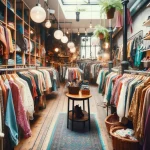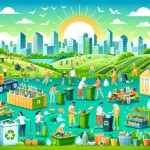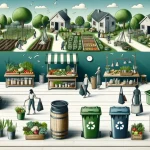
Discover the beauty of sustainable textiles for home use! Explore eco-friendly options like organic cotton, hemp, and linen to add a green touch to your decor.
Sustainable Textiles Key Takeaways:
- These textiles include organic cotton, hemp, linen, and bamboo, offering a green alternative for home decor.
- By choosing sustainable textiles, you contribute to reducing waste, conserving resources, and supporting ethical practices in the textile industry.
Discover the world of sustainable textiles for your home.
Learn about eco-friendly fabrics that not only enhance your living spaces but also contribute to a healthier planet.
From organic cotton to innovative materials like Qmonos, this guide will help you make conscious choices for a sustainable lifestyle.
Sustainable Textiles for Home Use
What Are Sustainable Textiles? Sustainable textiles are fabrics that are produced in an environmentally and socially responsible manner.
They aim to minimize the negative impacts on the environment and promote ethical practices in the textile industry.
Explore the significance of choosing sustainable textiles for your home and the planet.
Definition and Importance
Sustainable textiles are fabrics that are produced with minimal environmental impact, ensuring the conservation of resources and the well-being of workers throughout the production process.
These textiles are important because they help reduce the fashion and textile industry’s carbon footprint, water usage, and chemical pollution.
By choosing sustainable textiles, consumers can contribute to a more environmentally friendly and socially responsible industry.
Green textile
Green textiles are fabrics or fibres produced to replace environmentally harmful textiles and minimise the ecological impact. Green textiles (or eco-textiles) are part of the sustainable fashion and eco-friendly trends, providing alternatives to the otherwise pollution-heavy products of conventional textile industry, which is deemed the most ecologically damaging industry.
Green textiles may also refer to clothing or accessories designed to use organic or recycled materials, less packaging and more energy-efficient manufacturing. https://en.wikipedia.org/wiki/Green_textile
Environmental Impact
The environmental impact of textiles is significant, with conventional production methods consuming vast amounts of water, energy, and chemicals.
Sustainable textiles aim to mitigate these effects by using organic or recycled materials, reducing water and energy consumption, and minimizing the use of harmful chemicals.
This approach helps protect ecosystems, conserve natural resources, and reduce greenhouse gas emissions, contributing to a healthier planet.
Social Responsibility
Social responsibility in the context of sustainable textiles involves ensuring fair labor practices, safe working conditions, and equitable wages for all workers involved in the production process.
It also encompasses supporting local communities and preserving traditional craftsmanship.
By prioritizing social responsibility, companies and consumers can promote human rights, economic development, and ethical practices within the textile industry.
Sustainable Fabrics for Home Use
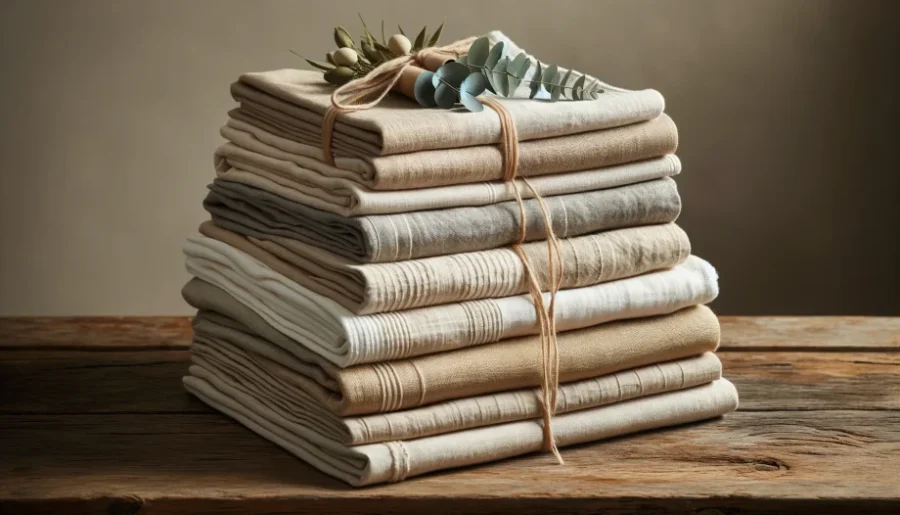
Embrace the world of sustainable fabrics for your home and make a positive impact on the environment.
From the cozy warmth of wool to the innovative eco-friendliness of ECONYL, these fabrics offer a variety of textures and properties that cater to your home decor needs while aligning with your eco-conscious values.
Discover the diverse range of sustainable textiles that can enhance the comfort and style of your living spaces.
- Hemp: Known for its strength and durability, hemp is a low-impact crop that requires minimal water and pesticides. Its versatility makes it ideal for various home textiles, including curtains, upholstery, and rugs.
- Organic Cotton: Cultivated without harmful chemicals, organic cotton is gentle on the skin and the environment. It’s perfect for bedding, towels, and other soft furnishings.
- Linen: Derived from the flax plant, linen is highly breathable and has a natural, rustic appeal. It’s a great choice for curtains, tablecloths, and bedding.
- Lyocell: Produced in a closed-loop process, lyocell is soft, absorbent, and biodegradable. It’s commonly used in bedding and drapery for its luxurious feel.
- Bamboo: Bamboo fabric is known for its softness and antimicrobial properties. It’s a sustainable choice for towels, bedding, and eco-friendly clothing.
- ECONYL: Made from regenerated nylon waste, ECONYL is a sustainable alternative to synthetic fabrics, ideal for durable upholstery and home accessories.
- Wool: A renewable resource, wool is naturally insulating and flame-resistant. It’s used in carpets, blankets, and upholstery for warmth and comfort.
- Piñatex: A cruelty-free leather alternative, Piñatex is made from pineapple leaf fibers. It’s used in home accessories and upholstery for a sustainable, stylish touch.
- Recycled Polyester: By repurposing plastic bottles, recycled polyester reduces waste and energy consumption. It’s used in various home textiles, including curtains and cushions.
- Deadstock: Utilizing surplus fabrics from the fashion industry, deadstock is a waste-reducing option for unique and limited-edition home textiles.
- Modal: A soft and silky fabric, modal is made from sustainably harvested beech trees. It’s often used in bedding and loungewear for its comfort and eco-friendliness.
- Qmonos: Inspired by spider silk, Qmonos is a synthetic, biodegradable fiber with high strength and elasticity. It’s a cutting-edge option for durable, eco-friendly textiles.
- Alginate Textiles: Derived from seaweed, alginate textiles are fully biodegradable and suitable for a variety of home textiles, such as disposable linens and filters.
- Common Sustainable Fabrics: This category includes other eco-friendly fabrics like jute, ramie, and organic wool, offering a wide range of options for sustainable home decor.
- Ecodear Fabric: Made from renewable resources like corn, Ecodear fabric is a sustainable alternative for home textiles, reducing dependency on fossil fuels.
- Leather: Sustainable leather options include vegetable-tanned or recycled leather, providing a durable and eco-conscious choice for upholstery and accessories.
- Recyclable Materials: Emphasizing the use of recyclable materials in textiles helps reduce waste and promotes a circular economy in the home decor industry.
- Silk: When produced ethically, silk is a luxurious and sustainable option for high-end home textiles, such as bedding and drapery.
- Tencel: Known for its sustainability and comfort, Tencel is a popular choice for bedding, towels, and other home textiles, offering a smooth and breathable feel.
By choosing sustainable fabrics for your home, you contribute to a healthier environment and support ethical practices in the textile industry.
Why Choose Sustainable Textiles for Your Home?
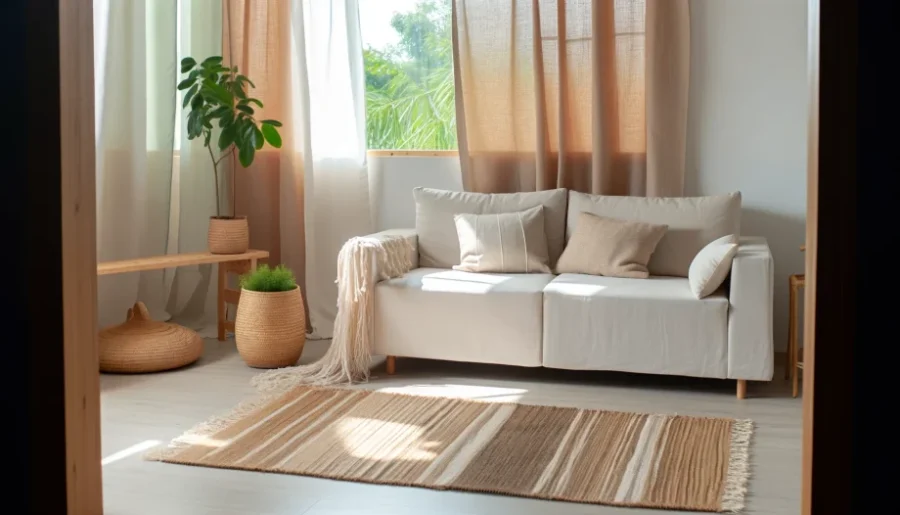
Choosing sustainable textiles for your home is not only an eco-friendly decision but also a step towards a healthier lifestyle.
Learn about the benefits of sustainable textiles, from reducing environmental impact to supporting ethical practices in the textile industry.
Environmental Benefits
Sustainable textiles offer significant environmental benefits by reducing the negative impacts associated with conventional textile production. These benefits include:
- Lower Water Usage: Sustainable textiles often require less water for cultivation and processing, helping to conserve this precious resource.
- Reduced Chemical Pollution: By avoiding harmful pesticides and chemicals, sustainable textiles minimize water and soil pollution, protecting ecosystems and wildlife.
- Decreased Carbon Footprint: Sustainable production methods and the use of renewable resources lead to lower greenhouse gas emissions, contributing to the fight against climate change.
- Waste Reduction: The use of recycled materials and the emphasis on durability in sustainable textiles help reduce waste in landfills.
Health Benefits
Choosing sustainable textiles for home use can also have positive effects on health:
- Reduced Exposure to Toxins: Sustainable textiles are often free from toxic chemicals used in conventional fabric processing, reducing the risk of skin irritation and allergies.
- Improved Indoor Air Quality: Natural and organic textiles tend to emit fewer volatile organic compounds (VOCs) than synthetic fabrics, contributing to better indoor air quality.
- Comfort and Breathability: Sustainable fabrics like organic cotton and linen are known for their breathability and comfort, enhancing overall well-being.
Ethical Considerations
Ethical considerations are a crucial aspect of sustainable textiles, encompassing:
- Fair Labor Practices: Sustainable textile production often involves fair wages, safe working conditions, and respect for workers’ rights, promoting social equity in the supply chain.
- Support for Local Communities: Many sustainable textile initiatives support local artisans and communities, preserving traditional crafts and contributing to economic development.
- Animal Welfare: Sustainable textiles that involve animal products, like wool or silk, often prioritize humane treatment and ethical sourcing practices.
- Transparency and Accountability: Ethical considerations also include transparency in production processes and accountability for the social and environmental impacts of textile manufacturing.
By focusing on environmental benefits, health advantages, and ethical considerations, sustainable textiles for home use offer a holistic approach to sustainability, promoting a healthier planet and a more just society.
How to Identify Sustainable Textiles
With so many options available, it can be challenging to identify truly sustainable textiles.
Discover key certifications, labels, and factors to look for when choosing sustainable fabrics for your home decor.
Certifications and Labels
Certifications and labels play a crucial role in identifying sustainable textiles.
They provide assurance that the fabrics meet specific environmental and social standards.
Some key certifications and labels to look for include:
- Global Organic Textile Standard (GOTS): This certification ensures that textiles are made from organic fibers and processed according to strict ecological and social criteria.
- OEKO-TEX Standard 100: A label indicating that the textile has been tested for harmful substances and is safe for human health.
- Fair Trade Certified: This certification focuses on fair labor practices, ensuring that workers are paid fair wages and work in safe conditions.
- Cradle to Cradle Certified: A certification that assesses the sustainability of a product across its entire lifecycle, from material health to social fairness.
Material Composition
The material composition of sustainable textiles is a key factor in their environmental impact. Sustainable fabrics are made from materials that are:
- Natural and Organic: Such as organic cotton, linen, and hemp, which are grown without harmful chemicals and pesticides.
- Recycled: Using recycled materials like polyester made from plastic bottles reduces waste and conserves resources.
- Biodegradable: Fabrics that can naturally decompose, like wool and silk, minimize environmental pollution at the end of their lifecycle.
Production Processes
The production processes used to create sustainable textiles are designed to minimize environmental impact and promote ethical practices. These processes include:
- Low-Impact Dyeing: Using water-efficient dyeing methods and non-toxic dyes to reduce water pollution.
- Energy Efficiency: Implementing energy-saving techniques in manufacturing to lower carbon emissions.
- Closed-Loop Systems: Recycling water and chemicals in the production process to reduce waste and conserve resources.
- Ethical Labor Practices: Ensuring that workers involved in the production of textiles are treated fairly and work in safe conditions.
By considering certifications and labels, material composition, and production processes, consumers can make informed choices when selecting sustainable textiles for home use, contributing to a more sustainable and ethical textile industry.
Incorporating Sustainable Textiles into Your Home Decor
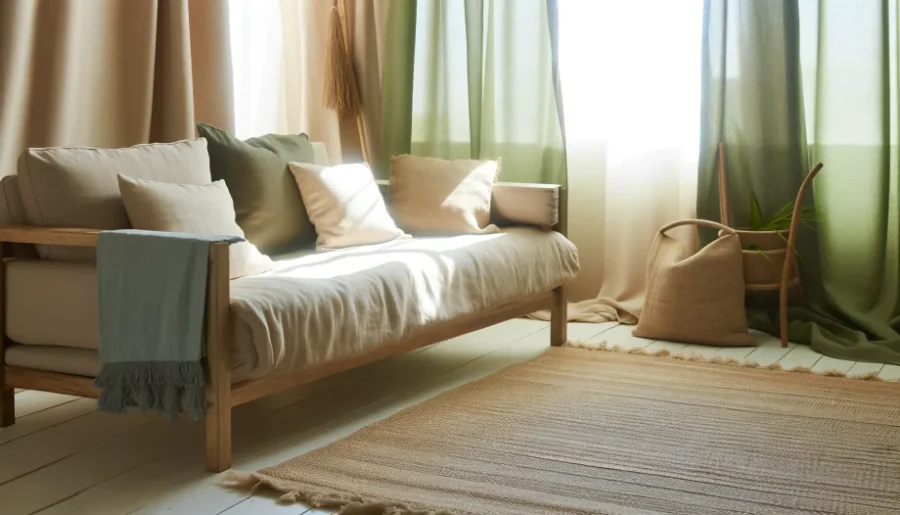
Transform your living spaces with sustainable textiles. Get inspired by creative ideas and tips for incorporating eco-friendly fabrics into your home decor, from curtains and upholstery to bedding and rugs.
Decorating Ideas
Decorating with sustainable textiles can add both style and eco-consciousness to your home. Here are some ideas:
- Curtains and Drapes: Choose organic cotton or linen curtains to add a natural, breathable touch to your windows.
- Upholstery: Reupholster furniture with sustainable fabrics like hemp or recycled polyester for a fresh, eco-friendly look.
- Bedding: Opt for bedding made from organic cotton or bamboo for a comfortable and sustainable night’s sleep.
- Table Linens: Use tablecloths and napkins made from natural fibers like linen or organic cotton for an eco-friendly dining setup.
- Throws and Pillows: Add warmth and texture to your living spaces with throws and pillows made from sustainable materials like wool or Tencel.
Sustainable Brands and Suppliers
When sourcing sustainable textiles, consider these reputable brands and suppliers:
- Coyuchi: Offers a wide range of organic cotton bedding, towels, and home textiles.
- West Elm: This brand features a selection of sustainable and fair-trade certified textiles for various home decor needs.
- Boll & Branch: Specializes in luxury organic cotton bedding and bath linens.
- Patagonia: Known for their commitment to sustainability, they offer a range of home textiles made from recycled materials.
- Eileen Fisher: Offers a collection of sustainable home textiles, including organic cotton and linen items.
DIY Projects
Engaging in DIY projects with sustainable textiles can be a fun and eco-friendly way to personalize your home decor:
- Fabric Wall Art: Create unique wall hangings using scraps of sustainable fabrics.
- Upcycled Cushion Covers: Transform old clothing or fabric remnants into stylish cushion covers.
- Reusable Shopping Bags: Sew your own shopping bags using sturdy materials like hemp or organic cotton.
- Quilts and Blankets: Piece together offcuts of sustainable fabrics to make cozy quilts or blankets.
- Window Treatments: Craft your own curtains or shades from natural fabrics to control light and add privacy.
Incorporating sustainable textiles into your home through thoughtful decorating ideas, supporting ethical brands, and engaging in DIY projects not only enhances the aesthetic of your living spaces but also contributes to a more sustainable and responsible lifestyle.
Sustainable Textiles for Home Use FAQs
Dive into our FAQ section to explore common questions about sustainable textiles for home use.
Whether you’re curious about the most eco-friendly fabrics or the impact of your textile choices on the environment, we’ve got you covered with concise and informative answers.
Get ready to expand your knowledge and make more conscious decisions for your home and the planet.
Q: What is a sustainable textile?
- A: A sustainable textile is a fabric that is produced in an environmentally and socially responsible manner, minimizing negative impacts on the planet.
Q: What is the most environmentally friendly fabric?
- A: Organic cotton, hemp, and linen are considered some of the most environmentally friendly fabrics due to their natural, renewable, and biodegradable properties.
Q: What fabrics are 100% biodegradable?
- A: Natural fabrics like cotton, linen, hemp, silk, and wool are 100% biodegradable under the right conditions.
Q: Why is sustainability an issue in textiles?
- A: Sustainability is an issue in textiles due to the industry’s significant environmental impact, including water and energy consumption, chemical use, and waste production.
Q: What is the most ethical and sustainable fabric?
- A: The most ethical and sustainable fabric is one that is produced with minimal environmental impact, fair labor practices, and animal welfare in mind, such as organic cotton or hemp.
Q: What fabric is least harmful to the environment?
- A: Fabrics like organic cotton, hemp, and linen are the least harmful to the environment due to their natural and sustainable production processes.
Q: What fabric is unsustainable?
- A: Conventional cotton, polyester, and other synthetic fabrics are considered unsustainable due to their high environmental impact and reliance on fossil fuels.
Q: What fabric takes the longest to decompose?
- A: Synthetic fabrics like polyester and nylon take the longest to decompose, often hundreds of years, due to their plastic-based composition.
Q: What is the most sustainable fabric you could buy and why?
- A: Organic cotton or hemp are among the most sustainable fabrics you can buy due to their low environmental impact, biodegradability, and renewable nature.
-
Q: Is bamboo more ethical than cotton?
- A: Bamboo can be more ethical than conventional cotton due to its faster growth, lower water usage, and natural pesticide-free cultivation, but it depends on the processing method.
Q: Is there sustainable polyester?
- A: Yes, sustainable polyester is made from recycled materials like plastic bottles, reducing the need for virgin resources and lowering environmental impact.
Q: Which fabrics have a lower carbon footprint?
- A: Fabrics like organic cotton, hemp, and linen have a lower carbon footprint compared to conventional cotton and synthetic fabrics.
Q: Why is cotton bad for the environment?
- A: Conventional cotton is bad for the environment due to its high water and pesticide usage, soil degradation, and contribution to water pollution.
Q: Is bamboo a sustainable fabric?
- A: Bamboo can be a sustainable fabric if produced using eco-friendly methods, but some processing techniques can reduce its sustainability.
Q: What material is the biggest polluter in the world?
- A: Plastic, including synthetic textiles like polyester, is one of the biggest polluters in the world due to its widespread use and slow decomposition rate.
Q: What material has the biggest carbon footprint?
- A: Materials like conventional cotton and synthetic fabrics have a significant carbon footprint due to their energy-intensive production processes.
Q: What product has the highest carbon footprint?
- A: Products made from synthetic materials and those requiring long-distance transportation typically have the highest carbon footprints.
Sustainable Textiles Conclusion
Embracing sustainable textiles for your home is a meaningful step towards a greener future.
By choosing eco-friendly fabrics, you contribute to a healthier environment and support ethical practices in the textile industry.
Let’s make conscious choices for a sustainable and stylish home.
The Future of Sustainable Textiles
Growing Awareness and Demand:
The future of sustainable textiles looks promising as awareness and demand for eco-friendly options continue to grow.
Innovations in Material Science and Production:
Innovations in material science and production processes are leading to the development of new sustainable fabrics with even lower environmental impacts.
Emerging Technologies:
Technologies like 3D printing and biofabrication are being explored to create textiles with minimal waste.
Biofabrication is usually defined as the production of complex biologic products from raw materials such as living cells, matrices, biomaterials, and molecules. This rapidly evolving technology has been stimulated by the development of 3D fabrication technologies. Science Direct
Circular Economy Model:
The circular economy model is gaining traction, emphasizing the importance of recycling and reusing textiles to reduce waste and conserve resources.
Consumer Consciousness:
As consumers become more conscious of their choices, the textile industry is expected to continue evolving toward sustainable fashion, with an emphasis on transparency, traceability, and ethical practices.
Resources Section
Embark on a deeper exploration of sustainable textiles with our curated selection of resources.
Whether you’re seeking further information, research, or inspiration, these authoritative non-commercial websites provide valuable insights into the world of eco-friendly textiles.
Dive into the wealth of knowledge they offer to enhance your understanding and commitment to sustainability in home textiles.
Resource Links:
- EPA Sustainable Materials Management: EPA Sustainable Materials Management – The EPA’s Sustainable Materials Management program provides resources and information on reducing environmental impacts through materials management, including textiles.
- UN Alliance for Sustainable Fashion: UN Alliance for Sustainable Fashion is an initiative by the United Nations that aims to align the fashion industry with the Sustainable Development Goals, offering resources on sustainable fashion and textiles.
- UN Environment Programme – Sustainable Fashion: UN Environment Programme – Sustainable Fashion – UNEP’s page on sustainable fashion provides insights and information on the environmental impacts of the fashion industry and the importance of sustainable textiles.
- Textile Exchange: Textile Exchange – A global non-profit organization that promotes sustainability in the textile industry, offering extensive resources on sustainable fibers and industry reports.
- The Sustainable Fashion Forum: The Sustainable Fashion Forum – A platform for discussions, education, and resources on sustainable fashion and textiles.
- Fashion Revolution: Fashion Revolution – A global movement advocating for transparency and sustainability in the fashion industry, with resources on ethical fashion and textile sustainability.
- Ellen MacArthur Foundation: Ellen MacArthur Foundation – A charity focused on promoting the circular economy, with resources on circular design and sustainable textiles.
- Global Organic Textile Standard (GOTS): Global Organic Textile Standard – An international organization providing certification for organic textiles, with information on standards and certified suppliers.
- The Organic Cotton Accelerator: The Organic Cotton Accelerator – A multi-stakeholder organization dedicated to promoting organic cotton, with resources on its environmental and social benefits.
- Wrap Love Your Clothes: Wrap Love Your Clothes – An initiative by the UK’s Waste and Resources Action Programme (WRAP) offering tips and resources for extending the life of clothes and reducing textile waste.
These resources offer a wealth of information to support your journey toward more sustainable textiles for home use. Explore them to deepen your understanding and discover practical ways to make a positive impact through your textile choices.

